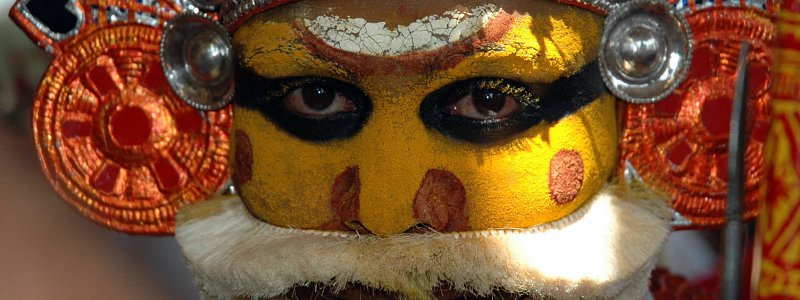Theyyam - the Gods come down to Malabar
One of the special things on offer for those who visit The Hermitage is a cultural event which is unique to Malabar – the Theyyam. Theyyam is the word for ‘God’ in Malayalam, the language of Kerala. This tells us immediately that Theyyam is not, as usually described, merely an artistic or theatrical dance performance but a religious ritual. In fact, it is a shamanic ritual of spirit possession, in which the dancer acts as a channel for the possessing entity. This spirit is usually a locally venerated aspect of a Hindu god or goddess, or sometimes an ancestor or hero from history or myth, and he or she blesses the community through the medium of the dancer’s body. The Theyyam season lasts from November to March each year, and a Theyyam can be hired to perform blessings for a new house, a marriage or any other important occasion.
Sociologically, Theyyam is interesting and important as it is a low caste celebration. For this reason the performance will never take place in a temple – which is typically run by orthodox brahmins - but can be found in family shrines or homes, open air venue or sites especially reserved for their use. Members of high castes, including brahmins, may well come to a Theyyam performance and take the blessings of the dancer like anyone else, but the line between temple worship and Theyyam is clear. One indication of this is that a Theyyam performance will often include the sacrifice of an animal – typically a cockerel – and the drinking of alcohol by the performer. These practices are familiar in village shrines all over India but taboo in a Keralan temple setting.
From the spectators’ point of view, one of the highlights of a Theyyam is the lengthy makeup session that precedes it. This can go on for four or five hours and is followed by the dancer assuming his costume which can feature huge towering headdresses, widely-hooped straw skirts and several layers of highly coloured dress, all of which vary according to which deity is being represented. Only if the dancer correctly attired will the deity agree to descend into his body. Once the make-up and dressing is completed, the dancer will sit on a stool and admire himself in a mirror. It is at this moment, when he first sees himself in his new incarnation, that the spirit will descend into his medium. From now on the human is no longer himself, but becomes instead the embodied divinity.
Theyyam dancers are always male and the skill and privilege is passed down from father to son, generation after generation. Different families will have the tradition of incarnating different deities. During the season, the dancer is a sanctified being and has to adhere to a vegetarian diet and celibate lifestyle and fulfil several other conditions. However, once the season is over, he will return to his normal, and often quite humble, job. The distinctions of the world that humans prize so much mean nothing to the gods; what they value is a pure heart and a willingness to serve and heed their advice. And it is the search for advice on everyday matters that draws most people to visit a Theyyam; in this capacity the dancer acts as a practical and down-to-earth oracle.
There is nothing down-to-earth about some of the performances though. The most spectacular ones tend to begin late at night and continue until dawn. These often involve fire-walking, or rather fire-jumping, as the dancer hurls himself time after time on a heap of red hot ashes that may be a dozen feet high and is pulled back off them by a rope tied to his waist. The Theyyam can also be very fierce with the assembled audience: criticising, insulting or charging into the spectators as he wields a sharp sword or spear and scatters the onlookers who only a moment ago may have been laughing as he picked on someone else in the crowd. This unpredictability is what gives the performance much of its edge - after all, who can say which way the god will move and what mood they will exhibit? Whatever may happen though will be deemed appropriate to those who have come together to be blessed by the divine forces unleashed in the Theyyam performance.
(For an interesting account of a modern Theyyam dancer who lives down the road from The Hermitage, see William Dalrymple’s excellent book ‘Nine Lives’, Chapter 5).





